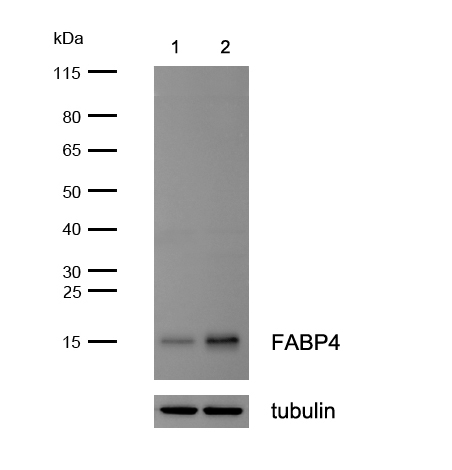Product Detail
Product NameFABP4 Rabbit mAb
Clone No.JM10-99
Host SpeciesRecombinant Rabbit
Clonality Monoclonal
PurificationProA affinity purified
ApplicationsWB, ICC/IF, IHC
Species ReactivityHu, Ms, Rt
Immunogen Descrecombinant protein
ConjugateUnconjugated
Other Names3T3-L1 lipid-binding protein antibody
422/aP2 antibody
A-FABP antibody
adipocyte antibody
Adipocyte lipid binding protein antibody
Adipocyte lipid-binding protein antibody
Adipocyte protein AP2 antibody
Adipocyte-type fatty acid-binding protein antibody
AFABP antibody
ALBP antibody
ALBP/Ap2 antibody
aP2 antibody
Epididymis secretory protein Li 104 antibody
FABP antibody
FABP4 antibody
FABP4_HUMAN antibody
Fatty acid binding protein 4 adipocyte antibody
Fatty acid binding protein 4 antibody
Fatty acid binding protein adipocyte antibody
Fatty acid-binding protein 4 antibody
Fatty acid-binding protein antibody
HEL S 104 antibody
Lbpl antibody
Myelin P2 protein homolog antibody
P15 antibody
P2 adipocyte protein antibody
Protein 422 antibody
Accession NoSwiss-Prot#:P15090
Uniprot
P15090
Gene ID
2167;
Calculated MW15 kDa
Formulation1*TBS (pH7.4), 1%BSA, 40%Glycerol. Preservative: 0.05% Sodium Azide.
StorageStore at -20˚C
Application Details
WB: 1:500-1:2,000
IHC: 1:50-1:200
ICC: 1:100-1:500
All lanes : FABP4 Rabbit mAb at 1/1k dilution Lane 1 : FABP4 knockout HAP1 cell lysate Lane 2 : Wild-type HAP1 cell lysate Lysates/proteins at 20 µg per lane.
Fatty acid-binding proteins, designated FABPs, are a family of homologous, cytoplasmic proteins that are expressed in a highly tissue-specific manner and play an integral role in the balance between lipid and carbohydrate metabolism. FABPs mediate fatty acid (FA) and/or hydrophobic ligand uptake, transport, and targeting within their respective tissues. The mechanisms underlying these actions can give rise to both passive diffusional uptake and protein-mediated transmembrane transport of FAs. FABPs are expressed in adipocytes (A-FABP), brain (B-FABP), epidermis (E-FABP, also designated psoriasis-associated FABP or PA-FABP), muscle and heart (H-FABP, also designated mammary-derived growth inhibitor or MDGI), intestine (I-FABP), liver (L-FABP), myelin (M-FABP) and testis (T-FABP). The human A-FABP gene is organized into 4 exons, maps to chromosome 8q21, and encodes a 132-amino acid protein. A-FABP protein comprises approximately 1% of the total cytosolic protein in human adipose tissue.
If you have published an article using product 49511, please notify us so that we can cite your literature.



 Yes
Yes



